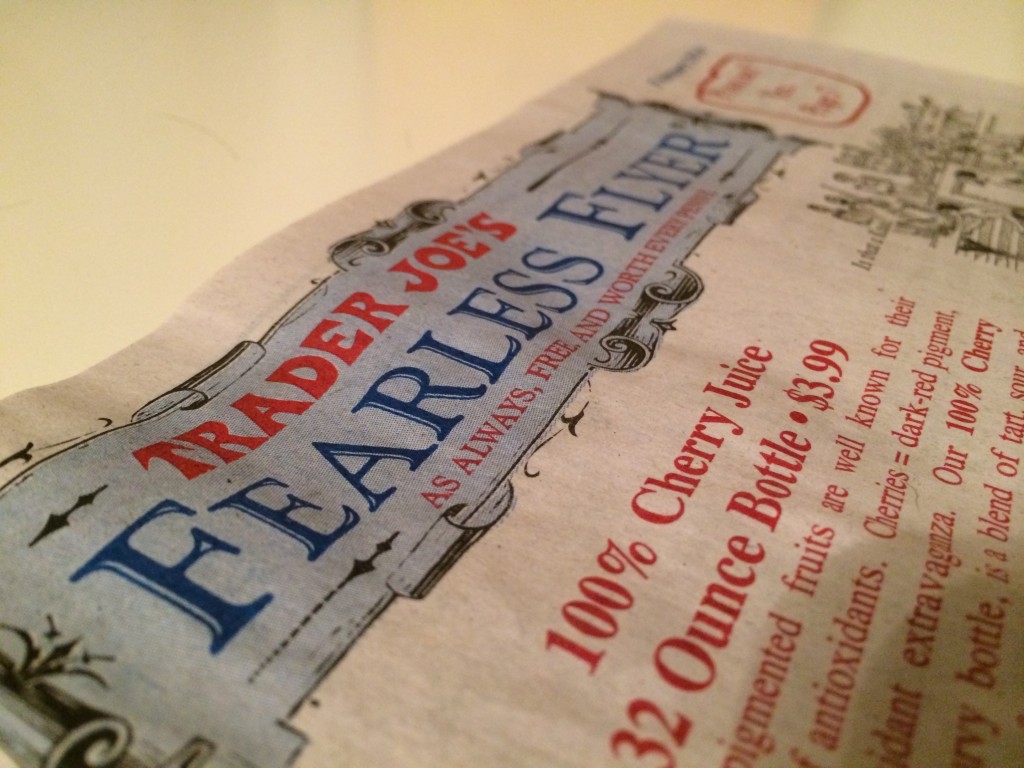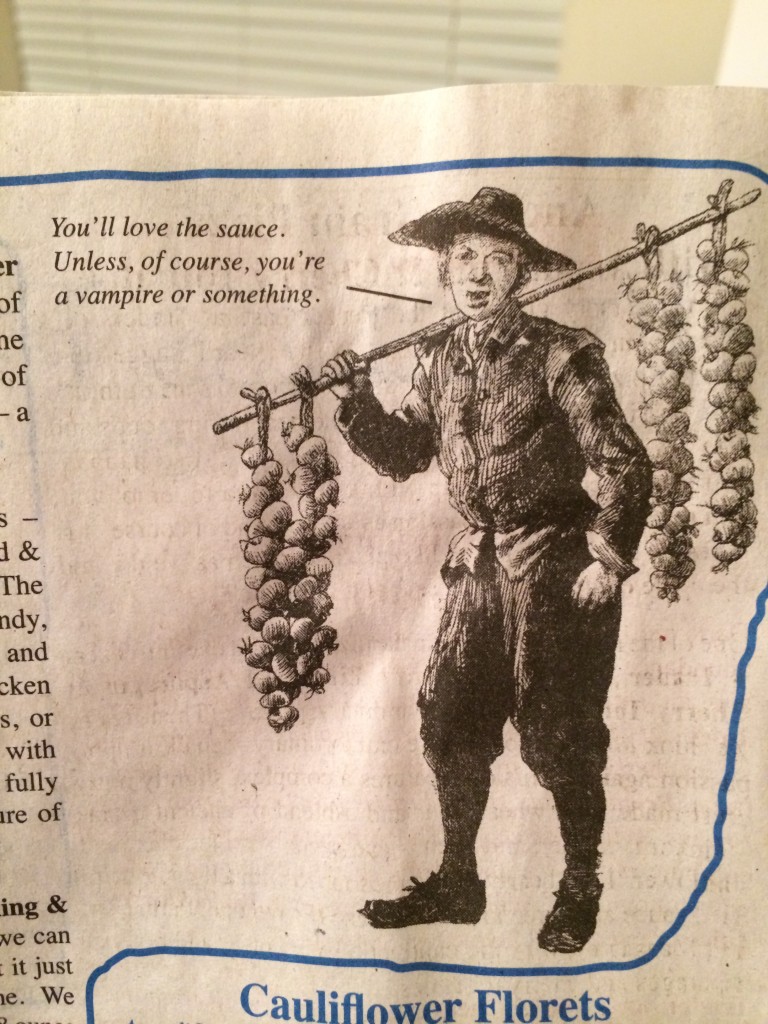Mention the words “Trader Joe’s” around the right person and you’re likely to encounter the definition of a rabid fan.
To you, it may just be a grocery store. To them? It’s a part of who they are as a person.
Shopping is of secondary importance when one visits Trader Joe’s. The real reason is simply to go to Trader Joe’s. It’s an experience—from the sample station, to the “good times, brah” employees, to the quirky and delicious products…it’s just fun.
And it all starts with one thing—their really cheap wine.
Just kidding. It all starts with their copy, of course! C’mon!
Trader Joe’s brand culture all begins with the copy that positions and describes their products—from fresh fruits and premade salads to frozen foods to bath and beauty products.
You’ll notice they don’t just sell cheese and crackers, they sell “Cave Aged Blue Cheese” and “Some Enchanted Crackers.”
Oh, and if you happen to pass one of their featured items in the store, you’ll see a card with a nice little chunk of copy that you want to read almost as badly as you want to buy the item.
But where Trader Joe’s really shines is their beloved print publication, the Fearless Flyer.

“As always, free, and worth every penny.”
As their website says, “The Fearless Flyer doesn’t fit neatly into just one category—as with most other good things. Is it a newsletter? A catalog? A comic-book? Yes, yes, and perhaps even yes!”
The Fearless Flyer is basically a little newspaper highlighting all the new, seasonal, and/or featured items in Trader Joe’s. It’s a big part of their brand culture and a big factor in creating an insatiable thirst for trying new and different items in the Trader Joe’s shopper.
Let’s take a look at the four copywriting tactics the Fearless Flyer does so well, and how you can apply them to your own business.
1. Disruptive Headlines (Product Names)
The first thing you need to know about Trader Joe’s products is that nearly all of them are “Trader Joe’s” brand name products—meaning they’re unique to the chain.

My current favorite TJ’s product. You can have some when you pry it from my cold, dead fingers.
You won’t find Honey-Nut Cheerios or Goldfish crackers there. But you will find Melodious Blend (“a masterful mélange of fully cooked green lentils, red lentils, and green garbanzo beans”), Cookie Butter (“a deliciously unusual spread reminiscent of gingerbread”), and Trader Joe’s and the Astounding Multi-Flavor Joe Joe’s (“Joe Joe’s sandwich cookies decadently enrobed in various chocolates”).
Beyond being quirky and fun, these product names do something that greatly contributes to the Trader Joe’s experience—they disrupt your typical “grocery store” mindset.
Whether you’re perusing the Fearless Flyer or the actual aisle, a bag of Druid Circles or a box of Cocoa Batons is likely to catch your eye.
Granted, not every Trader Joe’s product is given some elaborate, off-the-wall name. You’ll still see plenty of your standard chicken broth, tomato soup, extra virgin olive oil—though usually with the distinction of being some combination of organic, free-range, gluten-free, etc.
After all, if every product had a disruptive name, they’d eventually all run together.
2. Storytelling
This is the Fearless Flyer’s multigrain fiber bread and organic non-dairy butter. Trader Joe’s finds a way to interest you in every single featured product—whether you want it or not.
Remember the Cave Aged Blue Cheese mentioned earlier? Turns out the reason for the name is just as interesting as the name itself:
“Legend has it that the world’s first blue cheese was developed in the natural caves of France, where temperature and humidity conditions were ideal for this purpose. Trader Joe’s Cave Aged Blue Cheese continues this tradition in sandstone caves in Minnesota, where blue cheese has been crafted for more than 70 years – ours is aged for about 75 days.”
Beyond the occasional burger with blue cheese, I’m not even a blue cheese guy. Yet I had to keep reading.
If you’re looking for ways to fold storytelling into your own products, consider borrowing one of the three main devices Trader Joe’s uses:
- History
You just saw this one in action with the Cave Aged Blue Cheese example. If you’re selling something that’s been around for a long time, do a little research into its history.
Take flannel shirts, for example. Who invented flannel? What was its original purpose? What kind of people bought it?
You can dig up all sorts of interesting stories and facts when you start asking these kinds of questions.
- Source
Where was your product created? Who made it? What was the process like? Take this line from Trader Joe’s Organic Basmati Rice, for example:
“Trader Joe’s Organic Basmati Rice comes from the foothills of the Himalayas. There, the rice fields are watered by snow fed rivers that give the rice lovely flavor, unique aroma and delicate texture.”
Which package of basmati rice are you going to buy? The one that was grown with snow-fed Himalayan water…or the one that—as far as you know—came from aisle nine at Kroger?
- Interesting Tidbits
If the History and Source angles aren’t working out, never hesitate to weave a few fun facts together. You know, those little nuggets that people keep in their back pocket to throw out when they’re drowning in an awkward conversation. Things like:
“So uh, hey…Did you know that dark red-pigmented fruits are well known for their abundance of antioxidants? Oh, you didn’t? Pretty cool, I know. Well, see ya later!”
I borrowed that one from the copy for Trader Joe’s 100% Cherry Juice (which I would never drink because cherries are little medicine-tasting death bombs).
Storytelling takes customers behind-the-scenes of your product. It’s a great way to differentiate yourself from the competition while also presenting your product in a context that humans are hardwired to enjoy.
3. Sell the Experience, Not the Product
Most people don’t wander around thinking, Man, I’ve really got a craving for some multigrain crackers right now.
There are plenty of people, however, who are thinking, It would be fun to host a dinner party sometime soon.
Enter my favorite Trader Joe’s product name/tagline:
Some Enchanted Cracker
Multigrain Crackers Perfect for Entertaining
Trader Joe’s puts the cracker in the context of something the customer already has an emotional desire for. They’re not selling you a cracker; they’re selling you an elegant evening that will impress all your friends you secretly hate!
Fair Warning: It’s easy to take a one-way train to cheeseville with this tactic. Don’t overpromise. If the product will not literally change your customers’ lives, don’t tell them it will.
Trader Joe’s is smart enough to avoid overpromising with a bit of tongue-in-cheek humor mixed in throughout the copy:
“If crackers had theme songs, that Rogers & Hammerstein classic would be the note-perfect tune to represent Trader Joe’s Some Enchanted Cracker. You may not expect such greatness from a mere cracker; it may indeed seem like a stranger. But one bite and you’ll find your evening enchanted, for sure.”
Remember: sell the experience, but avoid hype or melodrama. Keep it real.

A cartoon dude hawking Trader Joe’s “Many Clove Garlic Sauce.” Another example of their disarming humor.
4. Sit on Your Customer’s Side of the Table
What are the painful/annoying aspects customers encounter when shopping for the type of product you’re selling? Identify them so you can empathize and alleviate their concern of encountering that pain with your product.
Let’s look back to our refined friend, Some Enchanted Cracker, for another fun-filled example!
“We’ve shopped for crackers elsewhere, and we’ve been surprised at how expensive they can be. At Trader Joe’s, you can buy a 10 ounce box of Some Enchanted Crackers for the everyday price of $2.49 – proof that there might just be something truly enchanted about these crackers after all.”
This is one of the best ways to build trust with your customer. Identify with their pain and explain how you have worked hard to eliminate it from the equation. Not only does this show you care, it also demonstrates that you’ve put real thought into the product and—in some cases—the price point.
Go Forth…and Trader Joe-ify Your Copy!
Remember, you don’t need to always try to work every single one of these into any copy you write. Just consider them five more tools at your disposal. Keep them in mind, and try implementing one or two when the conditions are right.
There are three main reasons why Trader Joe’s has created such a formidable army of raving fan customers—unusually reasonable prices, quality (and tasty) products, and a remarkably unique brand culture.
It’s no surprise that they go to great lengths to create copy that reflects all three.
Question: How do you plan on incorporating any of these tactics in your own copy?
*Featured photo credit: Anthony92931
